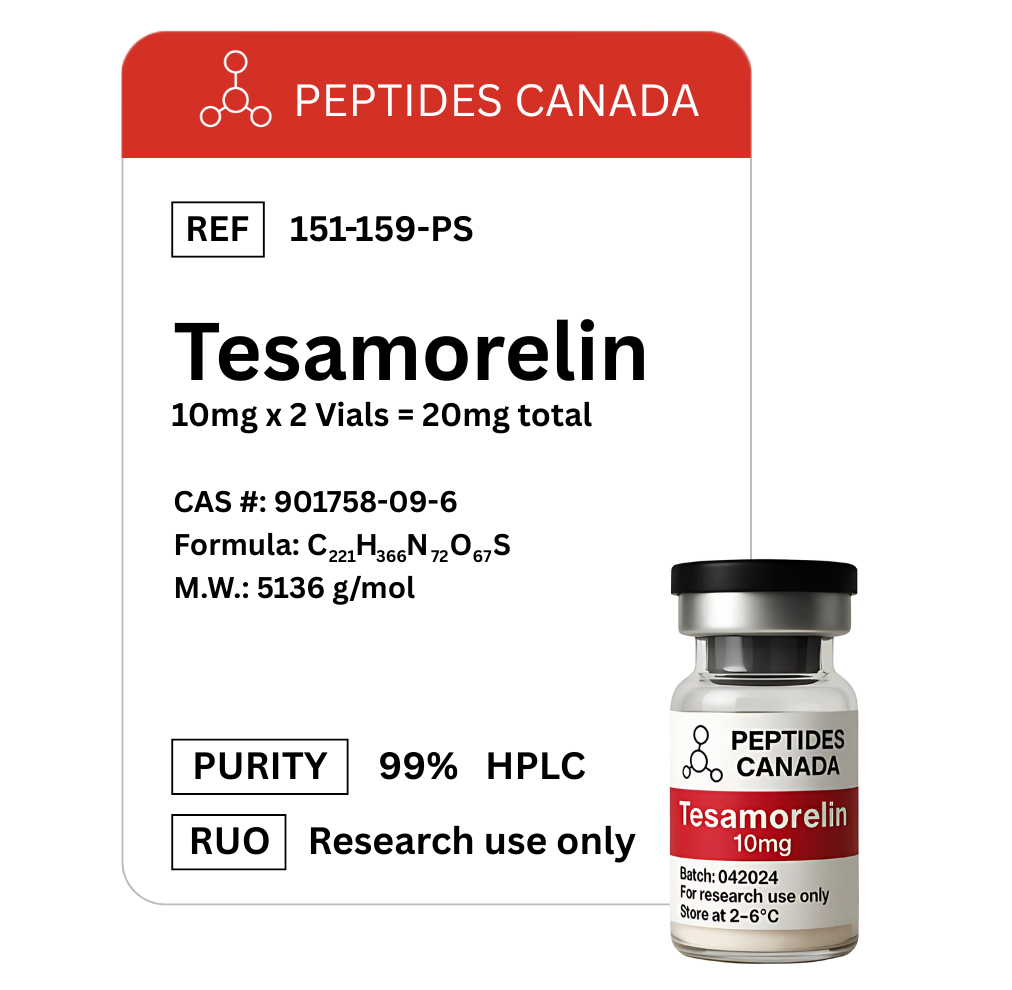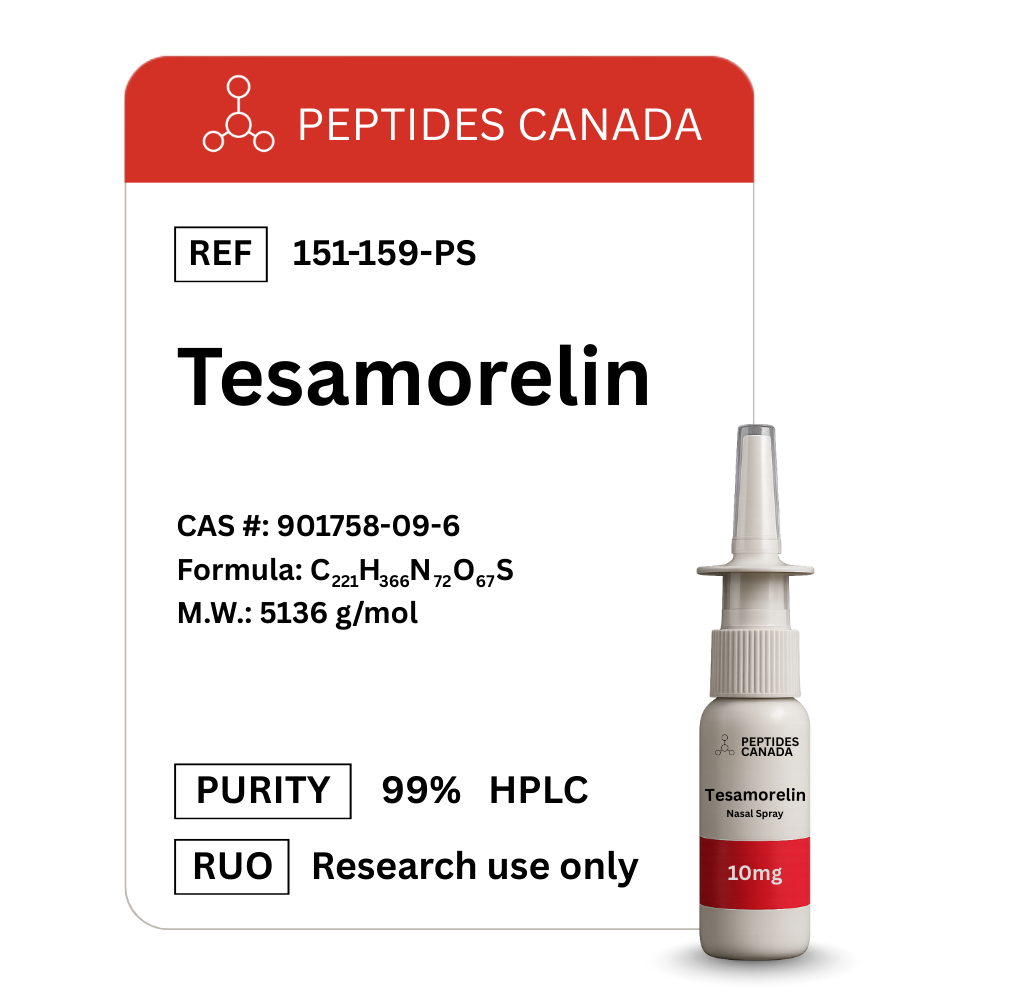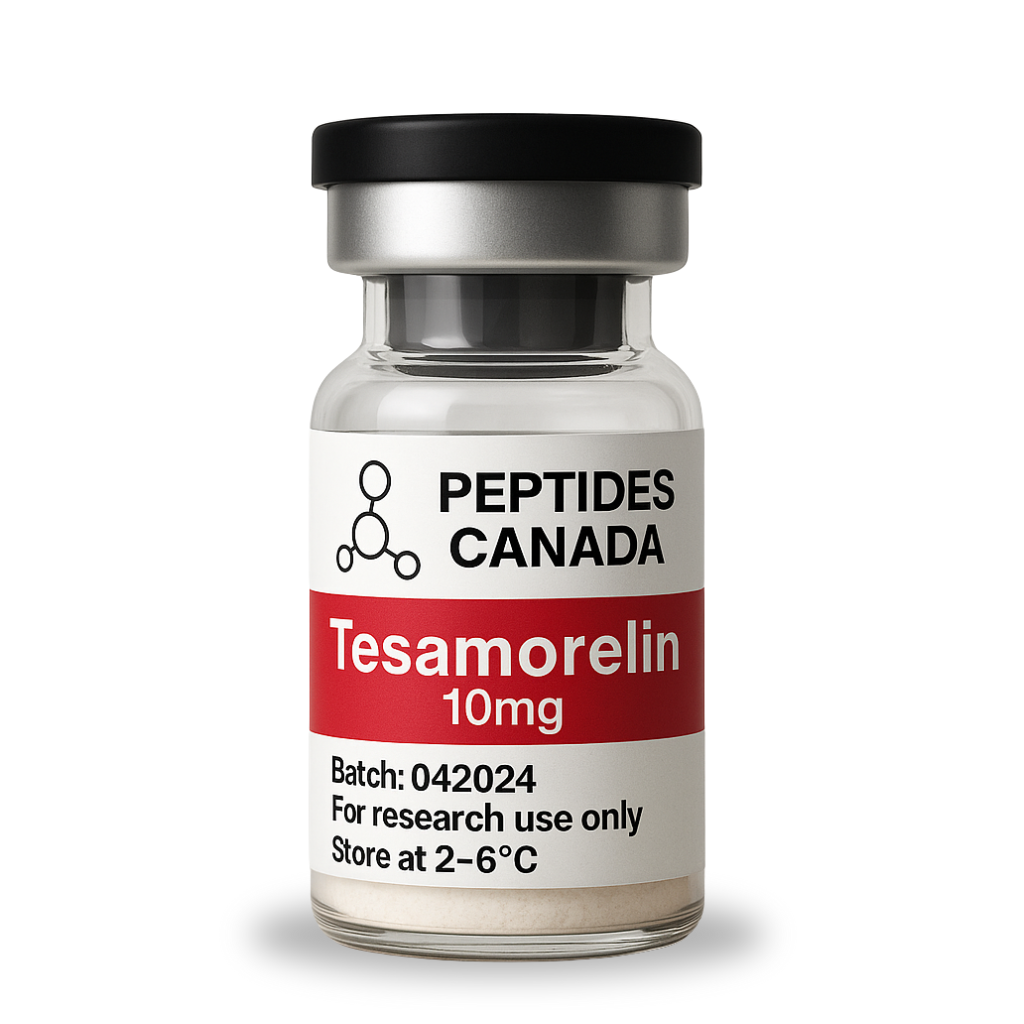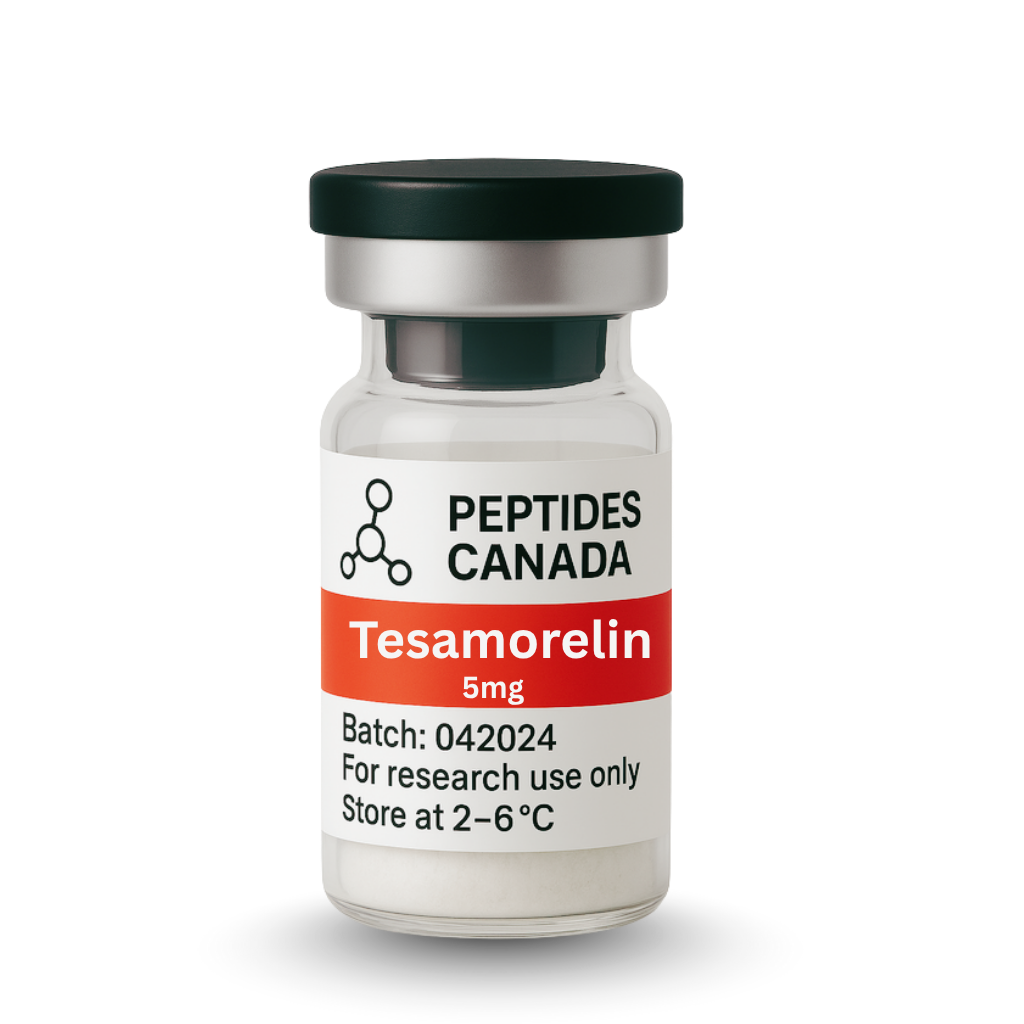Tesamorelin
From CAD $75 CAD $110
Contents: Tesamorelin
Form: Powder
Purity: 99.7%
TESTED FOR:
- PURITY
- STERILITY
- WEIGHT
- ENDOTOXINS(LPS)
Free Reconstitution solution automatically added to your cart with each order of vial.
This product is Made, Tested & Shipped From Canada.
Ships Today
Order by 1:00 PM EST
Free Shipping
For 2 or more vials
99%+ Purity Guaranteed
COA Verified+
Trackable Shipping
Tesamorelin Peptide
Tesamorelin is a synthetic polypeptide of 44 amino acids, analogous to growth hormone–releasing hormone. The N-terminus has been modified relative to native GHRH, a change researchers suggest may improve stability.
Tesamorelin has been examined for a mechanism similar to GHRH via receptors in the anterior pituitary, potentially increasing production and release of growth hormone. Growth hormone acts on several tissues, including hepatocytes, and can stimulate systemic insulin-like growth factor-1 (IGF-1) synthesis. Growth hormone may also stimulate local IGF-1 production within various tissues.
Overview
IGF-1 is cited as the main anabolic mediator of growth hormone, promoting growth and limiting programmed cell death. Growth hormone itself is described as lipolytic, encouraging fat breakdown at defined depots such as abdominal and visceral fat stores. Tesamorelin appears to stimulate growth hormone release and downstream IGF-1 by interacting with GHRH receptors in anterior pituitary cells. When Tesamorelin binds the GHRH receptor, investigators hypothesize that receptor conformation and downstream signaling may shift. It is also proposed that Tesamorelin can increase intracellular cyclic AMP in certain cells through adenylate cyclase, converting ATP to cAMP. Higher cAMP may activate protein kinase A, which relays signals to multiple targets. The combined GHRH-receptor stimulation and cAMP-PKA pathway is proposed to promote growth hormone secretion and distribution from somatotrophs. Reported findings include an estimated 69% increase in overall growth hormone exposure by AUC and a roughly 55% rise in mean pulse area, while peak or frequency of pulses showed no change. IGF-1 levels reportedly increased by about 122%.
Both peptide termini of GHRH are altered in Tesamorelin. These changes are associated with greater stability and increased resistance to enzymatic deactivation. The C-terminus carries a trans-3-hexenoyl group, a modification often referenced for protection against enzymatic breakdown. The N-terminus bears an acetyl group (CH3CO), which can enhance stability and bioactivity. Chemically, Tesamorelin is designated N-(trans-3-hexenoyl)-[Tyr1]hGHRF(1-44)NH2 acetate.
Chemical Makeup
Molecular Formula: C₂₂₁H₃₆₆N₇₂O₆₇S
Molecular Weight: 5136 g/mol
Other Known Titles: (3E)-hex-3-enoylsomatoliberin
Research and Clinical Studies
Tesamorelin Peptide and Lipodystrophy
Lipodystrophy refers to abnormal fat distribution and metabolism, including loss of fat from some regions and excess deposition in others. It is often associated with insulin resistance and elevated cholesterol and triglycerides. In phase III work, 806 subjects were studied over 26 weeks with a 26-week extension. One group (n=543) received Tesamorelin and the remainder placebo; after 26 weeks the cohorts were re-randomized for another 26 weeks. At week 26, Tesamorelin was associated with a significant reduction in visceral adipose tissue of at least 15.4%. Triglyceride and cholesterol levels were also significantly lower than in the placebo group.
Tesamorelin Peptide and Immunodeficient Fat Fractions
Serious immunodeficiencies may drive non-alcoholic fatty liver disease in a substantial fraction of HIV-positive subjects. In one study, 61 HIV-positive participants with high hepatic fat fraction (HFF) received Tesamorelin or placebo for 12 months. At study end, 35% of subjects on Tesamorelin showed an HFF reduction of less than 5% compared with only 4% on placebo reporting any HFF decrease. No change in glucose levels was reported.
Tesamorelin Peptide and Cognition
A clinical study in immunodeficient models with mild cognitive impairment assessed neurological outcomes. One hundred subjects older than 40 years received daily Tesamorelin for 6 months, followed by a 6-month period without peptide, then reintroduction once daily for another 6 months. The primary outcome was change in Global Deficit Score at 6 and 12 months. The trial is ongoing and final results have not been published.
Tesamorelin Peptide and Insulin
A 12-week randomized clinical study in 53 subjects with type 1 diabetes evaluated insulin sensitivity. Participants received lower-dose Tesamorelin, higher-dose Tesamorelin, or placebo. After 12 weeks, fasting glucose, HbA1c, and insulin dose were unchanged across groups, indicating no significant difference among arms.
Tesamorelin Peptide and Muscle Tissue
Computed tomography was used to evaluate structural quality of muscle after Tesamorelin. Specific muscle groups, including rectus abdominis, psoas major, and paraspinal muscles, showed notable changes. Depending on the site, density and size increased, or intramuscular fat decreased, with differences relative to placebo reaching statistical significance.
Tesamorelin Peptide and Visceral Fat
Visceral obesity is the buildup of fat around and within internal organs and is common in lipodystrophy. It is linked with insulin resistance, impaired glucose handling, and dyslipidemia. Research on Tesamorelin has suggested reductions in visceral fat of up to 25% in lipodystrophy models, highlighting a possible path for metabolic improvement.
Tesamorelin peptide is available for research and laboratory purposes only. Please review and adhere to our Terms and Conditions before ordering.
References:
- Clinical and Research Information on Drug-Induced Liver Injury [Internet]. Bethesda (MD): National Institute of Diabetes and Digestive and Kidney Diseases; 2012-. Tesamorelin. [Updated 2018 Oct 20]. https://www.ncbi.nlm.nih.gov/books/NBK548730/
- Spooner, L. M., & Olin, J. L. (2012). Tesamorelin: a growth hormone-releasing factor analogue for HIV-associated lipodystrophy. The Annals of pharmacotherapy, 46(2), 240–247. https://doi.org/10.1345/aph.1Q629
- Stanley TL, Chen CY, Branch KL, Makimura H, Grinspoon SK. Effects of a growth hormone-releasing hormone analog on endogenous GH pulsatility and insulin sensitivity in healthy men. J Clin Endocrinol Metab. 2011 Jan;96(1):150-8. doi: 10.1210/jc.2010-1587. Epub 2010 Oct 13. PMID: 20943777; PMCID: PMC3038486. https://www.ncbi.nlm.nih.gov/pmc/articles/PMC3038486/
- Ferdinandi ES, Brazeau P, High K, Procter B, Fennell S, Dubreuil P. Non-clinical pharmacology and safety evaluation of TH9507, a human growth hormone-releasing factor analogue. Basic Clin Pharmacol Toxicol. 2007 Jan;100(1):49-58. doi: 10.1111/j.1742-7843.2007.00008.x. PMID: 17214611. https://pubmed.ncbi.nlm.nih.gov/17214611/
- Stanley, T. L., Fourman, L. T., Feldpausch, M. N., Purdy, J., Zheng, I., Pan, C. S., Aepfelbacher, J., Buckless, C., Tsao, A., Kellogg, A., Branch, K., Lee, H., Liu, C. Y., Corey, K. E., Chung, R. T., Torriani, M., Kleiner, D. E., Hadigan, C. M., & Grinspoon, S. K. (2019). Effects of tesamorelin on non-alcoholic fatty liver disease in HIV: a randomised, double-blind, multicentre trial. The lancet. HIV, 6(12), e821–e830. https://www.ncbi.nlm.nih.gov/pmc/articles/PMC6981288/
- Falutz J, Mamputu JC, Potvin D, Moyle G, Soulban G, Loughrey H, Marsolais C, Turner R, Grinspoon S. Effects of tesamorelin (TH9507), a growth hormone-releasing factor analog, in human immunodeficiency virus-infected patients with excess abdominal fat: a pooled analysis of two multicenter, double-blind placebo-controlled phase 3 trials with safety extension data. J Clin Endocrinol Metab. 2010 Sep;95(9):4291-304. doi: 10.1210/jc.2010-0490. Epub 2010 Jun 16. PMID: 20554713. https://pubmed.ncbi.nlm.nih.gov/20554713/
- Tesamorelin Effects on Liver Fat and Histology in HIV. https://clinicaltrials.gov/ct2/show/NCT02196831
- Phase II Trial of Tesamorelin for Cognition in Aging HIV-Infected Persons. https://clinicaltrials.gov/ct2/show/record/NCT02572323
- Clemmons, D. R., Miller, S., & Mamputu, J. C. (2017). Safety and metabolic effects of tesamorelin, a growth hormone-releasing factor analogue, in patients with type 2 diabetes: A randomized, placebo-controlled trial. PloS one, 12(6), e0179538. https://www.ncbi.nlm.nih.gov/pmc/articles/PMC5472315/
- Adrian S, Scherzinger A, Sanyal A, Lake JE, Falutz J, Dubé MP, Stanley T, Grinspoon S, Mamputu JC, Marsolais C, Brown TT, Erlandson KM. The Growth Hormone Releasing Hormone Analogue, Tesamorelin, Decreases Muscle Fat and Increases Muscle Area in Adults with HIV. J Frailty Aging. 2019;8(3):154-159. doi: 10.14283/jfa.2018.45. PMID: 31237318; PMCID: PMC6766405. https://www.ncbi.nlm.nih.gov/pmc/articles/PMC6766405/
- Sivakumar T, Mechanic O, Fehmie DA, Paul B. Growth hormone axis treatments for HIV-associated lipodystrophy: a systematic review of placebo-controlled trials. HIV Med. 2011 Sep;12(8):453-62. doi: 10.1111/j.1468-1293.2010.00906.x. Epub 2011 Jan 25. PMID: 21265979.
Dr. Marinov
Dr. Marinov (MD, Ph.D.) is a researcher and chief assistant professor in Preventative Medicine & Public Health. Prior to his professorship, Dr. Marinov practiced preventative, evidence-based medicine with an emphasis on Nutrition and Dietetics. He is widely published in international peer-reviewed scientific journals and specializes in peptide therapy research.
HIGHEST QUALITY PEPTIDES
Our products are scientifically formulated and manufactured in cGMP-compliant facilities.
FAST DELIVERY
Enjoy fast and reliable 3–5 day shipping.
Dedicated Customer Service
Our customer service team is highly knowledgeable in peptide research and its applications. We’re available 24/7 to assist you.
Tested. Verified. Trusted.
We take a laboratory-first approach to quality. Each batch is made under controlled conditions and verified by an independent lab (HPLC/MS). We only ship batches that test ≥99% purity, and we provide a full COA, including identity, methods, and chromatograms, for your review.
See the Process for Yourself
We make our peptides in our own cGMP lab. Watch the video to see how every vial is produced, tested, and handled with care.
Science Behind Our Peptides
A clear explanation of how our peptides work, their benefits, why quality matters for best results, and what you should know.
Categories
Categories
How do I know the peptides I order are exactly what the label says?
Every vial we sell comes from a lab that follows current Good Manufacturing Practices (cGMP). That means each step of production is documented and controlled. Before a batch is released, it’s tested by independent third-party labs for purity, identity, and sterility. Certificates of analysis are available so you can see the exact test results.
Are your peptides produced in a sterile and controlled environment?
Yes. The labs we work with use ISO-certified clean rooms where air quality, equipment, and handling procedures are tightly regulated. Staff are trained to pharmaceutical-grade standards. This ensures the peptides are produced in an environment that minimizes contamination risks.
What about shipping? Do the peptides remain stable in transit?
Peptides in lyophilized (freeze-dried) form are stable at room temperature for transport. Once you receive them, refrigeration is recommended to maintain long-term integrity. We package every order securely to prevent damage and ship promptly, so your vials arrive in optimal condition.
How do I know you actually make these peptides yourselves?
We operate under strict in-house protocols that follow current Good Manufacturing Practices (cGMP). That means our team oversees the entire process from sourcing raw amino acids to the final lyophilized vial. Nothing is outsourced or repackaged. This gives us full control over purity, consistency, and sterility, and it’s why we can stand behind every single vial we ship.
What should I do with the vials once they arrive?
Store them in the refrigerator, away from direct light and heat. If you need to keep them longer, some peptides can be stored frozen. Each vial comes with clear handling instructions so you know the proper conditions for stability.
What proof do you have that your peptides are legitimate?
The strongest proof is transparency. For every peptide, we can provide certificates of analysis, manufacturing documentation, and references to the published scientific research behind it. If you ever have questions, we’ll show you the data rather than ask you to take our word for it.






